Labor and Delivery
Problems
Preterm Labor
Note to readers from
the Brookside Associates:
Although this page faithfully
reproduces the original Operational Medicine 2001, there is a
better (updated, with pictures) version of it in
Military Obstetrics & Gynecology. |
Most labors occur within 2 weeks of the due date. Labor occurring prior to the 38th
week of pregnancy is preterm labor, although definitions vary depending on the clinical
circumstances.
While delivering a little bit early usually poses no particular problem for the mother
or the baby, more significant amounts of prematurity pose more significant risks for the
infant. Of these, immaturity of the respiratory tree is among the most hazardous, but
other organs can also be a problem.
The cause of preterm labor is unknown, but in about half the cases, it is associated
with detectable intrauterine infection. Another significant number are associated with
placental abruption.
Our instincts are to try to prevent preterm delivery to avoid the morbidity associated
with it. This instinct is based on the premise that the problem is primarily one of
prematurity. If, however, preterm labor in a particular patient is just a symptom of an
underlying problem (infection, fetal stress, etc.), then vigorous attempts to prevent
delivery, when successful, may only delay treatment of the underlying problem. Further,
the medications commonly used to prevent premature delivery have significant side effects
and risks. For these reasons, judgment is used to decide who should be treated for preterm
labor and who shooed be allowed to deliver. In many civilian hospitals, no attempt is made
to arrest labor after the 34th week.
Threatened preterm labor consists of regular, frequent contractions (every 10 minutes)
that do not lead to a change in the cervix. In many civilian hospitals, it is customary to
withhold any labor-stopping medication until cervical change is noted. These civilian
hospitals also have abundant resources to treat preterm labor and premature infants should
labor unexpectedly progress rapidly. In an operational setting, such resources may not be
available and earlier treatment may be indicated.
In military settings, it is often helpful to postpone delivery long enough to get the
patient to a definitive care setting, even if the patient is more than 34 weeks gestation.
It is best to coordinate the use of these medications with the receiving facility. Any of
the following treatments may effectively disrupt the labor process for 24-48 hours, and
this is usually long enough to move the patient to an area of greater resource.
-
Magnesium sulfate, 4 gm loading dose over
at least 5 minutes, followed by 2 gm/hour in a steady IV drip. Watch for magnesium
toxicity with diminished reflexes and respiratory depression, and treated with calcium.
-
Ritodrine (Yutapar) 100 µg/minute IV, increased
every 15 minutes by 50 µg to a maximum of 350 µg/min. Titrate dosage to a maternal pulse
of not less than 100 BPM and not greater than 120 BPM. Watch for pulmonary edema in the
mother.
-
Terbutaline 0.25 mg SQ, every 1-4 hours x 24
hours, total dose not to exceed 5 mg in 24 hours. May also be given PO in 2.5 - 7.5 mg
doses, every 1.5 - 4 hours. Target maternal pulse rate is > 100 and < 120 BPM
-
Indomethacin (Indocin), 50 mg PO (or 100 mg
PR), followed by 25 mg PO every 4-6 hours for up to 48 hours. Watch for gastric bleeding,
heartburn, nausea and asthma.
-
Nifedipine, 10 -20 mg PO every 4-6 hours (Watch
for headache, flushing and nausea).
While postponing delivery, many fetuses less than 34 weeks gestation will benefit from
administering steroids to the mother. The effect of the steroids on the fetus is to
accelerate fetal pulmonary maturity, lessening the risk of respiratory distress syndrome
of the newborn. Appropriate doses include:
When transporting the mother to a definitive care setting, have her remain way over on
her left or right side, with a pillow between her knees, and an IV securely in place. If
IV access is lost during a bumpy truck or helo ride, it will be nearly impossible to
restart it without stopping or landing.
Premature Rupture of Membranes
Most women will rupture their membranes during labor. If membranes rupture prior to the
onset of labor, this is called premature rupture of the membranes, or PROM.
The obstetrical significance of PROM is that labor needs to begin promptly or infection
will develop with bacteria ascending through the birth canal. In some cases of PROM, the
reason the membranes rupture prematurely is because there is an established infection
which has weakened the membranes.
|
 |
|
Pelvic Exam During Labor Video
Pelvic
examinations during labor are used for several purposes, among them
assessment of cervical dilatation, effacement, station of the presenting
part, presentation, position, and pelvic capacity. This 5-minute video
demonstrates these techniques, using live patients, models and graphics.
www.brooksidepress.org |
|
|
|
If the pregnancy is at full term and there is no evidence of infection, no treatment is
necessary initially, because most women will go into spontaneous labor within the next 6
hours. After 6 hours of rupture, or in the face of infection or other pressing clinical
circumstance, labor can be induced. Unless infection is evident, antibiotics are not
helpful.
When PROM occurs remote from term, two basic approaches can be taken...induce
labor or wait for the fetus to mature further. There are pros and cons to each approach
and the decision will hinge on individual clinical circumstances. This decision is best
made in consultation with a definitive care facility.
Confirmation of PROM is optimally made via a sterile speculum examination, looking for
pooled amniotic fluid in the vagina, Nitrazine positive
fluid, ferning positive fluid, and to obtain a culture of the fluid.
Abnormal Presentation
A fetus in transverse lie cannot deliver vaginally and requires a cesarean section to
avoid uterine rupture during labor. Some of these women will also have a placenta previa
(as the cause of the transverse lie). Others will need an urgent cesarean because of
prolapsed cord. Without the fetal head or butt occupying the birth canal, it is relatively
easy for an umbilical cord to prolapse through a widely dilated cervix with ruptured
membranes.
A compound presentation may be resolvable if the fetus can be encouraged to withdraw
the hand, for example.
If the fetus and arm are relatively small in comparison to the maternal pelvis, vaginal
delivery may still be possible, but with some risk of injury to the arm.
|

Anterior Fontanel
|
The bones of the fetal scalp are soft and meet at "suture lines."
Over the forehead, where the bones meet, is a gap, called the "anterior
fontanel," or "soft spot." This will close as the baby grows during the 1st
year of life, but at birth, it is open.
The anterior fontanel is an obstetrical landmark because of its' distinctive diamond
shape. Feeling this fontanel on pelvic exam tells you that the forehead is just beneath
your fingers.
|
|
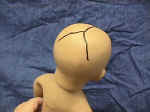
Posterior Fontanel
|
The occiput of the baby has a similar obstetric landmark, the "posterior
fontanel."
This junction of suture lines in a Y shape that is very different from the
anterior fontanel.
In cases of fetal scalp swelling or significant molding, these landmarks may become
obscured, but in most cases, they can identify the fetal head position as it is engaged in
the birth canal.
|
|
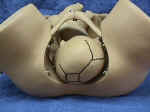
LOA
|
The fetal position is usually described using three letters.
This is an example of LOA, meaning:
In other words, the fetal occiput is directed towards the mother's left, anterior side.
ROA means:
These anterior presentations are normal and usually are the easiest way for the fetus
to traverse the birth canal.
|
|
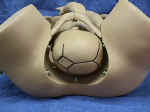
LOT
|
This LOT (Left, Occiput, Transverse) position and its' mirror image, ROT, are common in
early labor.
As labor progresses and the fetal head descends, the occiput usually rotates
anteriorly, converting this LOT to an LOA or OA as the head delivers.
If the head fails to rotate despite steady descent, this is called a "deep
transverse arrest," and is common among:
-
Babies who are too big to come through, and
-
Mothers with flat pelvises that favor a transverse delivery
Women with this condition who fail to deliver spontaneously are treated with cesarean
section, forceps, or vacuum extraction, depending on the clinical circumstances, available
resources, and experience of the operator.
|
|
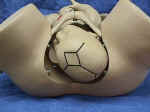
LOP |
LOP (Left Occiput Posterior) and ROP (Right Occiput Posterior) are positions favored by
certain internal pelvic shapes. This position has some obstetrical significance.
-
Normally, if the head is at 0 Station, the biparietal diameter is at the pelvic inlet
and the head is fully engaged. In posterior positions, at 0 Station, the biparietal
diameter is still a couple centimeters above the pelvic inlet, meaning that the head is
not fully engaged.
-
Babies can deliver in the posterior position, but the pelvis needs to be large enough
and it usually takes longer.
-
Forceps are often used to deliver babies in this position, but there is controversy
whether the fetus should be delivered in the posterior position, or rotated with the
forceps to the anterior position. Much depends on the clinical circumstances and the
experience of the operator.
|
Prolonged Latent Phase Labor
Latent phase labor lasting longer than 20 hours in a woman having her first baby or
more than 14 hours in other women is considered a "prolonged latent phase."
Women with a prolonged latent phase risk exhaustion and an increased risk of uterine
infection (chorioamnionitis).
No single treatment of prolonged latent phase will necessarily be successful in nudging
the patient into active phase labor, but each of the following have been successful in
many patients:
Arrest of Active Labor
Normal labor progresses at a rate of no less than 1.2 cm/hour (for first babies) to 1.5
cm/hour (for subsequent babies). If active labor progresses more slowly than this, an
"arrest of labor" has occurred.
The arrest of labor may be simple slowing of the labor below the expected rate, or may
represent a complete arrest, in which there is no further progress for at least 2 hours.
There are essentially only two causes for an arrest of labor:
Contractions may be inadequate because they are too infrequent (more than 4 minute
intervals), or do not last long enough (less than 30 seconds). Often in this situation,
they are neither frequent enough nor long enough.
Mechanical impediments to labor may include:
-
Absolute feto-pelvic disproportion, in which the maternal pelvis is not large enough to
allow the baby to pass through the birth canal.
-
Relative feto-pelvic disproportion, in which there is a snug fit, but given time and
adequate contractions, the baby can safely negotiate the birth canal
-
Fetal malposition, in which the fetal head is presenting in a less favorable position
(for example, occiput posterior, or with fetal hand preceding the head, or a transverse
lie)
-
Asynclitism, in which the fetal head is angled slightly to one side, making it more
difficult for a clear passage through the birth canal.
Inadequate contractions are treated with uterine stimulation. This is generally
accomplished with intravenous oxytocin, delivered in steady, small amounts with a
controlled infusion pump. The dose is started relatively low, and then advanced gradually
until the desired effect is achieved. Later in labor, the dosage is often adjusted
downward or stopped altogether if the contractions are too close together (consistently
more than 5 contractions every 10 minutes).
In an operational setting where a controlled infusion pump is not available, two other
options can be employed:
-
10 units of oxytocin are put in a 1-liter IV. With
one hand on the maternal abdomen to palpate uterine contractions, the other hand adjusts
to flow rate of the IV. Initially, just a few drops are infused and the effect assessed.
If the patient shows no unusual degree of sensitivity, the IV flow rate is gradually
increased until the desired effect is obtained. This will often take 45 minutes to an hour
of careful adjustment.
-
This technique is not as safe as a controlled infusion pump, but it is still safe enough
to be used if the need for oxytocin is great and the
resources are limited.
-
A common occurrence with this technique is overstimulation of the uterus resulting in a
prolonged, tetanic contraction. Usually this will resolve with time, but occasionally it
is so severe as to cause a uterine rupture. For that reason, careful monitoring of the
fetus during this application of oxytocin is very
important and immediate availability of surgical resources is very desirable.
-
Nipple stimulation (rolling the nipple back and forth with thumb and forefinger) will
cause of release of the mother's own oxytocin from her pituitary gland. This will have the
effect of stimulating contractions. Stimulating both nipples will have about double the
effect as stimulating one nipple. After about 15-20 minutes of nipple stimulation you will
have released about as much natural oxytocin as is available. Nipple stimulation can be
repeated at a later time, after the natural oxytocin supply has been replenished.
-
While this technique can be effective, the biggest problem is overstimulation of the
uterus because of too much oxytocin. Rather than achieving more frequent, longer
contractions, you will end up with a single, 3-5 minute contraction that is threatening to
the fetus and the integrity of the uterus. With that warning in mind, if the need is great
and resources are limited, nipple stimulation can be effective in stimulating labor.
-
Start with stimulation of just one nipple. Have the mother perform this on herself. It
usually takes 3-5 minutes of this before you will notice any effect on the uterus. If
gentle nipple stimulation is not effective, increase the strength of the nipple massage.
If there is still no result, you can try stimulating both nipples. Just make sure to give
the uterus enough time to respond.
The possibility of a mechanical impediment should be considered whenever arrest
disorders occur.
-
If the fetus is in a transverse lie, it will not be able to deliver vaginally and
continuing labor will ultimately lead to uterine rupture.
-
If the fetus is in an occiput posterior position, vaginal delivery may still be
successful, but it will take longer.
-
If the fetus is a little large for the birth canal, vaginal delivery may still be
successful, but only with time and fetal molding to the shape of the pelvis.
-
If there is a compound presentation (head and hand, for example), the baby may still
come through, but it may take much longer. (Try pinching the hand to see if the fetus will
react by pulling it up and out of the way.)
Usually, there is no way to know in advance which labors will experience an absolute
obstruction and those that will not. For this reason, a trial of labor is almost always
indicated. Those patients with an absolute obstruction will demonstrate a complete arrest
pattern and will need cesarean section.
Shoulder Dystocia
Shoulder dystocia means difficulty with delivery of the fetal shoulders. Although this
is more common among women with gestational diabetes and those with very large fetuses, it
can occur with babies of any size. Unfortunately, it cannot be predicted or prevented.
|
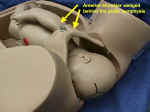
|
After delivery of the head, the fetus seems to try to withdraw back into the birth
canal (the "Turtle Sign"). Digital exam reveals that the anterior shoulder is
stuck behind the pubic symphysis.
In more severe cases, the posterior shoulder may be stuck at the level of the sacral
promontory.
|
|
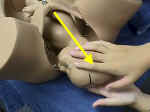
|
Excessive downward traction, applied to try to get the baby out, can lead to injury to
the nerves in the neck and shoulder (brachial plexus palsy) and should be avoided.
While most of these nerve injuries heal spontaneously and completely, some do not.
A generous episiotomy can be helpful. If a spontaneous laceration has occurred, or if
the perineum is very stretchy and offers no obstruction, it is not necessary to also
perform an episiotomy.
Gentle downward traction can be attempted initially to try to free the shoulder.
If this has no effect, do not exert increasing pressure. Instead, try some alternative
maneuvers to free the shoulder.
|
|
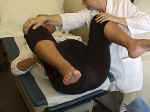
|
The MacRobert's Maneuver involves flexing the maternal thighs tightly against her
abdomen. This can be done by the woman herself or by assistants.
By performing this maneuver, the axis of the birth canal is straightened, allowing a
little more room for the shoulders to slip through.
While in the MacRobert's position, gentle downward traction can again be attempted.
|
|
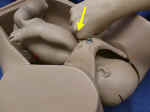
|
Suprapubic pressure can be applied to drive the fetal shoulder downward, clearing the
pubic bone.
It is usually easiest to have an assistant apply this downward pressure while the birth
attendant applies coordinated, gentle downward traction.
|
|
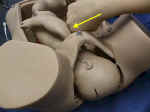
|
Sometimes, the suprapubic pressure is more effective if applied in a somewhat lateral
direction, rather than straight down.
This tends to nudge the shoulder into a more oblique orientation, which in general
provides more room for the shoulder.
Gentle downward traction on the fetal head in combination with this suprapubic pressure
may relieve the obstruction.
|
|
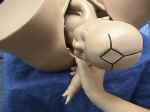
|
Often, the posterior arm has entered the hollow of the sacrum. By reaching in
posteriorly and sweeping the arm up and out of the birth canal, enough additional space
will be freed to allow the anterior shoulder to clear the pubic bone.
This drawing makes the maneuver look easier than it is. Because of limited visibility
and space, this maneuver is sometimes difficult or impossible.
Identify the posterior shoulder and follow the fetal humerus down to the elbow. Then
you can identify the fetal forearm. Grasping the fetal wrist, draw the arm gently across
the chest and then out.
|
|
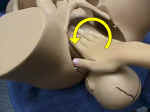
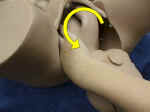
|
If you try to remove an electric light bulb by simply pulling it out, it won't work.
If, however, you unscrew the light bulb, it comes out relatively easily.
The concept of unscrewing the light bulb can be applied to shoulder dystocia problems.
This model shows the birth attendant pushing the anterior shoulder in a
counterclockwise direction. As the baby rotates, the posterior shoulder comes up outside
of the subpubic arch. At the same time, the stuck anterior shoulder is brought posteriorly
into the hollow of the sacrum. As the rotation continues a full 360 degrees, both
shoulders are rotated (unscrewed) out of the birth canal.
Applying fundal pressure in coordination with other maneuvers may, at times, be
helpful. Applied alone, it may aggravate the problem by further impacting the shoulder
against the symphysis.
|
|
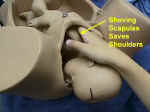
|
Two variations on the unscrewing maneuver include:
-
Shoving the shoulder towards the fetal chest ("shoving scapulas saves
shoulders"), which compresses the shoulder-to-shoulder diameter, and
-
Shoving the anterior shoulder rather than the posterior shoulder. The anterior shoulder
may be easier to reach and simply moving it to an oblique position rather than the
straight up and down position may be sufficient
|
Breech Delivery
Breech babies can present in a variety of ways, including buttocks first, one leg or
both legs first.
Frank breech means the buttocks are presenting and the legs are up along the fetal
chest. This is the safest position for breech delivery.
If either foot is presenting ("footling breech"), there are increased risks
of umbilical cord prolapse and delivery of the feet through an incompletely dilated
cervix, leading to arm or head entrapment. Because of the risks of breech delivery, in
many civilian hospitals most or all breech babies are born by cesarean section. In
operational settings, cesarean section may not be available or may be more dangerous than
performing a vaginal breech delivery.
The simplest breech delivery is called a spontaneous breech. The mother pushes the baby
out with the normal bearing down efforts and the baby is simply supported until it is
completely free of the birth canal. These babies pretty much deliver themselves.
This works best with smaller babies, mothers who have delivered in the past, and frank
breech presentation.
If the breech baby gets stuck half-way out, or if there is a need to speed the
delivery, an "assisted breech" delivery is performed. For this type of delivery,
it is very helpful to have a second person to aid you.
A generous episiotomy will give you more room to work, but may be unnecessary if the
vulva is very stretchy and compliant.
|
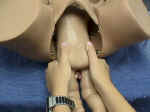
|
Grasp the baby so that your thumbs are over the baby's hips. Rotate the torso so the
baby is face down in the birth canal.
A towel can be wrapped around the lower body to give the you a more stable grip.
|
|
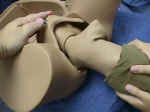
|
Have your assistant apply suprapubic pressure to keep the fetal head flexed.
Exert gentle outward traction on the baby while rotating the baby first clockwise and
then counterclockwise a few degrees to free up the arms.
If the arms are trapped in the birth canal, you may need to reach up along the side of
the baby and sweep them, one at a time, across the chest and out of the vagina.
|
|
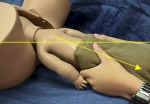
|
It is important to keep you hands low on the baby's hips. If you grasp the baby above
the hips, it is relatively easy to cause soft tissue injury to the abdominal organs,
including the kidneys.
During the delivery, always keep the baby at or below the horizontal plane or axis of
the birth canal.
|
|
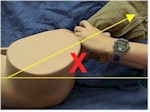
|
If you bring the baby's body above the horizontal axis, you risk injuring the baby's
spine.
Only when the baby's nose and mouth are visible at the introitus is it wise to bring
the body up.
The application of suprapubic pressure by the assistant is important for keeping the
head flexed against the chest, expediting delivery, and reducing the risk spinal injury.
At this stage, the baby is still unable to breath and the umbilical cord is likely
occluded.
Without rushing, move steadily toward a prompt delivery.
Placing your finger in the baby's mouth may help you control the delivery of the head.
Try not to let the head "pop" out of the birth canal. A slower, controlled
delivery is less traumatic.
|
Twin Delivery
About 40% of twins present as cephalic/cephalic. The remainder pose some abnormal
presentation of one or both twins. Because of the abnormal presentations and the
complexities of delivering twins, many are delivered by cesarean section in civilian
settings. Some physicians favor cesarean delivery for all twins. In many operational
settings, this approach may not be available or wise, and vaginal delivery may be
performed.
Following delivery of the first twin, there is a period of time during which
contractions slow or stop. Both placentas remain inside the uterus and attached.
It is usually safest to make no attempt to speed up this process, but to await the
resumption of contractions. This could take a few minutes or many minutes. While waiting,
monitor the second twin's heart beat and if normal, continue to observe the patient.
If contractions do not promptly resume, it is acceptable to stimulate the uterus with
oxytocin.
With your hand in the vagina, feel the fetal presenting part. If it is not engaged, try
to guide it down to the pelvic inlet. Avoid rupturing membranes until the fetal presenting
part is engaged in the birth canal.
As the presenting part descends, ask the mother to bear down and usually the second
twin will deliver as easily as the first twin. First twins are usually bigger than their
sibling.
Prolapsed Umbilical Cord
If a portion of the umbilical cord comes out of the cervix or vulva ahead of the fetus,
this is called a prolapsed umbilical cord.
This can be a big problem for the fetus if the cord is compressed, blocking the flow of
blood to the baby.
Immediate delivery is the best solution to this problem.
If immediate delivery is not available, put the mother in the knee-chest position and
use your hand in her vagina to elevate the fetal head back up into the uterus. This action
may relieve enough pressure on the umbilical cord that oxygen can still get through to the
baby. Transport the mother in the knee-chest position and you with your hand elevating the
fetal presenting part to the nearest facility in which immediate delivery is possible.
Umbilical Cord Around the Neck
This is a frequent occurrence during delivery. Nearly half of babies have the umbilical
cord wrapped around something (neck, shoulder, arm, etc.), and this generally poses no
particular problem for them.
In a few cases, the cord will be wrapped so tightly around the baby's neck (after
delivery of the head but before the shoulders are delivered) that you cannot get the rest
of the baby out without risk of tearing the umbilical cord.
-
If you can easily slip the cord over the baby's head, go ahead and do that.
-
If the cord is relatively loose, and allows the baby to be born with the cord around
its' neck, go ahead and do that.
-
If the cord is tight and disallows any manipulation, double clamp the cord and cut
between the clamps. This will free the cord. With this approach, prompt delivery of the
rest of the baby is important.
Retained Placenta
After delivery of the baby, the placenta will detach from the inside of the uterus and
will be expelled, often with additional pushing efforts by the mother. Normally this
occurs within a few minutes of delivery of the baby, but may take as long as an hour.
Often after about 30 minutes of waiting, a manual removal of the placenta is
undertaken. Anesthesia (regional or general) is typically used for this as manual removal
causes a great deal of abdominal cramping. In operational settings, if necessary, it may
be performed without anesthesia or with some IV narcotic analgesia.
One hand is inserted through the introitus and into the uterine cavity. Grasp the edge
of the placenta and use the side of your hand to sweep the placenta off the uterus. Then
pull the placenta through the cervix. Most placentas can be easily and uneventfully
removed in this way. A few prove to be problems.
When you manually remove the placenta, be prepared to deal with an abnormally adherent
placenta (placenta accreta or placenta percreta). These abnormal attachments may be
partial or complete.
-
If partial and focal, the attachments can be manually broken and the placenta removed.
It may be necessary to curette the placental bed to reduce bleeding. Recovery is usually
satisfactory, although more than the usual amount of post partum bleeding will be noted.
-
If extensive or complete, you probably won't be able to remove the placenta in other
than handfuls of fragments. Bleeding from this problem will be considerable, and the
patient will likely end up with multiple blood transfusions while you prepare her for a
life-saving, post partum uterine artery ligation or hysterectomy. If surgery is not
immediately available, consider tight uterine and/or vaginal packing to slow the bleeding
until surgery is available.
Post Partum Hemorrhage
Average blood loss following a delivery is about 500 cc. Bleeding that is significantly
in excess of that is considered post partum hemorrhage.
Most cases of post partum hemorrhage are caused by the uterus not contracting firmly
after delivery. In some cases, there is a retained blood clot inside the uterus which
disallows a firm, tight contraction. Manually expressing the blood clot by squeezing the
fundus will usually control bleeding from this source.
Uterine massage is an immediate treatment, often very effective, in stopping the
bleeding. Oxytocin can be added:
-
Oxytocin 20 units in 1 liter of IV fluids, run
briskly (wide open) for a few minutes will flood the mother with a strong uterotonic
agent.
-
Oxytocin 10 units IM will take longer to be
effective, but will have a more sustained action and is immediately available without an
IV.
-
Methylergonovine maleate 0.2 mg IV or IM
will firmly contract the uterus, but should be used cautiously if at all in women with
pre-existing hypertension.
-
Prostaglandin F-2-alpha can be
effective but is rarely available in operational settings.
Bimanual compression of the uterus is an effective way of slowing or stopping the
bleeding associated with post partum hemorrhage.
The uterus is elevated out of the pelvis by the vaginal hand, and compressed against
the back of the pubic bone by the abdominal hand.
Blood transfusion may be life saving in some of these patients.
In a non-pregnant patient, progressive hypovolemia is usually accompanied by the
predictable signs of tachycardia, hypotension and tachypnea before confusion and loss of
consciousness occur. Women with immediate post partum hemorrhage do not necessarily follow
that path and may look surprisingly well until they collapse. Because of this, your
decision to give or not give blood to these women should depend heavily on your estimated
blood loss, clinical circumstances and likelihood of continuing blood loss, and less on
her vital signs. Women who quickly lose half their blood volume (2500 out of 5000 ml)
usually benefit from transfusion.
In civilian settings, banked blood is usually given. In many operational settings,
banked blood is not available and fresh, whole blood will be used.
Read more
about blood transfusions in operational settings
Chorioamnionitis
Chorioamnionitis is an infection of the placenta and fetal membranes.
In its' earliest stage, there may be no symptoms or clinical signs. As it becomes more
advanced, clinical evidence of infection may appear, including:
-
Elevated maternal temperature above 100.4.
-
Elevated maternal white blood count
-
Fetal tachycardia
-
Foul-smelling amniotic fluid
-
Uterine tenderness
Chorioamnionitis may be a problem for both the mother and the fetus. Maternal
infections can prove to be very serious. The fetus may suffer not just from infection, but
also because of the elevated core temperature of the mother. Increased core temperatures
lead to an increased metabolic rate of the fetal enzyme systems, which in turn need more
oxygen than normal. At times, this increased oxygen demand cannot be met and the fetus may
become progressively acidotic.
Chorioamnionitis during labor is usually treated very aggressively, with
broad-spectrum, intravenous antibiotics such as:
Maternal temperature is treated with oral or rectal acetaminophen, 1 gm every 4 hours.
Plans are made for prompt delivery.
Group B Streptococcus
GBS is a source of significant morbidity and sometimes mortality. Many women are
asymptomatic carriers.
A variety of schemes to reduce perinatal GBS infections have been proposed and used in
different civilian settings. In operational settings, once good way of dealing with this
issue is to treat on the basis of risk factors.
Using this approach, women with any of the following risk factors are treated for
possible GBS:
-
Previous infant with invasive GBS disease
-
Documented GBS bacteruria during this pregnancy
-
Delivery at <37 weeks gestation
-
Ruptured membranes 18 hours or longer
-
Fever during labor of 100.4 or greater
Treatment consists of:
-
Penicillin G, 5 million units IV, followed by
2.5 million units IV every 4 hours until delivery, or
-
Ampicillin 2 gm IV, followed by 1 gm IV every 4
hours until delivery, or
-
Clindamycin 900 mg IV every 8 hours, or
-
Erythromycin 500 mg IV every 6 hours until
delivery, or
-
Other broad-spectrum antibiotics if clinically indicated
Post Partum Fever
Maternal febrile morbidity is classically defined as temperatures exceeding 100.4 on at
least two occasions, at least 6 hours apart.
For patients with an obvious infection with high fever, localizing signs and septic in
appearance, treatment is initiated prior to fulfillment of the 6-hour definition.
Cultures from the urine and vagina (and sometimes blood) can be useful in civilian
settings. In operational settings, their value may be limited. Similarly, a chest x-ray,
which might be ordered and promptly obtained in a civilian setting may not be available or
of any practical value in a military setting.
Examine the patient, looking for localizing signs that will guide you in your therapy.
Check for:
-
Uterine tenderness, suggesting a uterine or endometrial source
-
Flank tenderness, suggesting pyelonephritis
-
Breast tenderness and redness, suggesting mastitis
-
Perineum tenderness and redness, suggesting wound infection
-
Pulmonary rales, rhonchi or wheezes, suggesting a respiratory source
-
Calf tenderness, suggesting deep vein thrombophlebitis
If a specific source is identified, treatment specific for that source can be employed.
However, in operational settings, there is considerable risk of multiple sources and
vigorous antibiotic therapy is generally initiated. Good choices for such therapy include:
Home
|





















